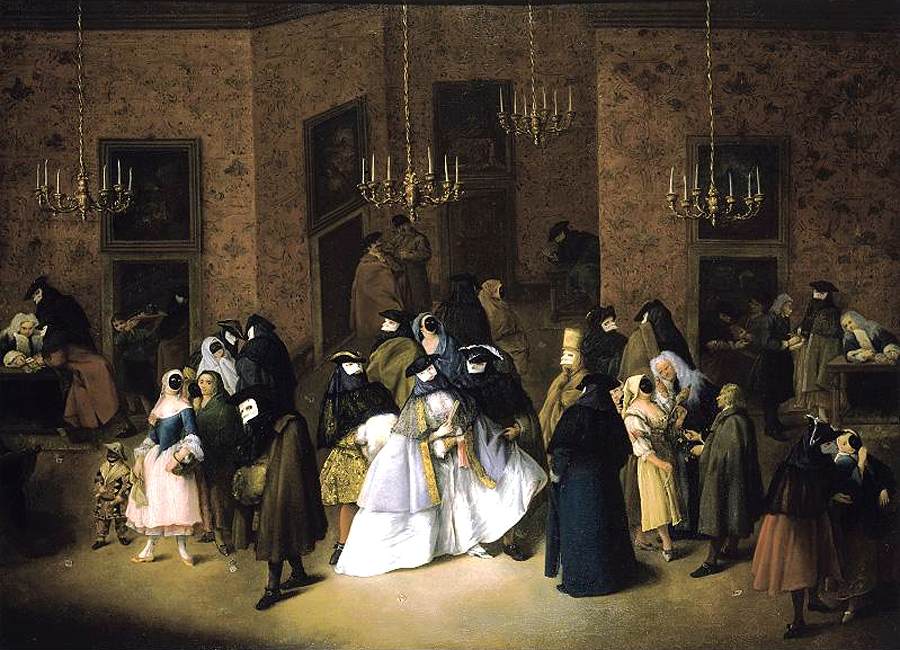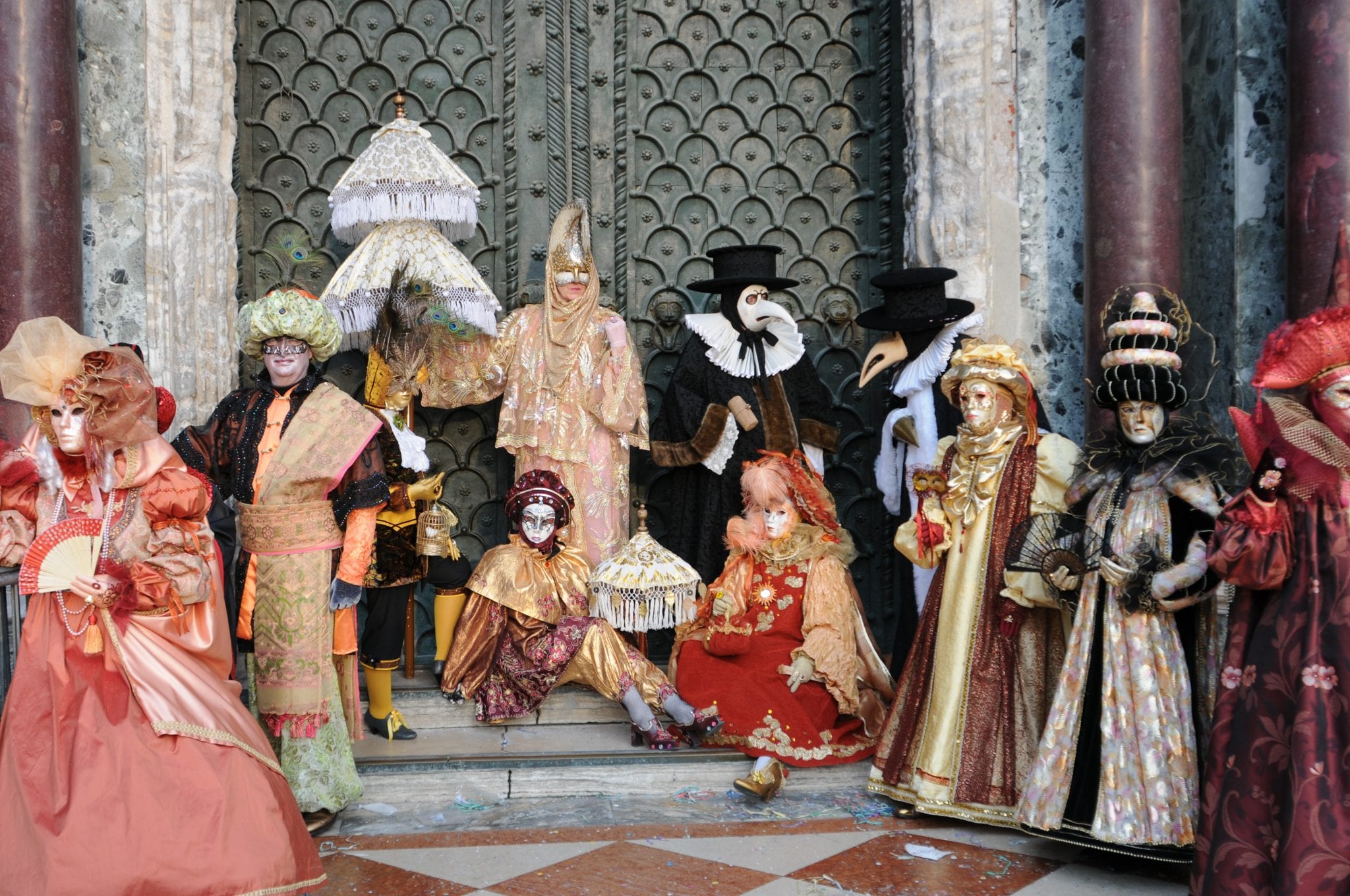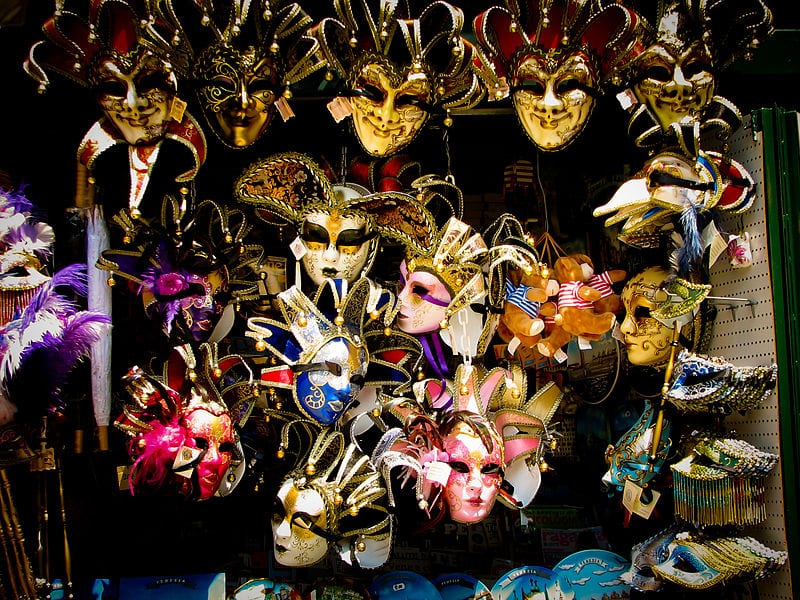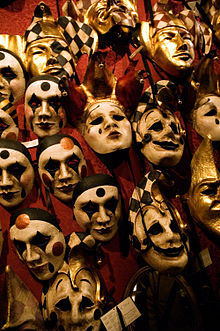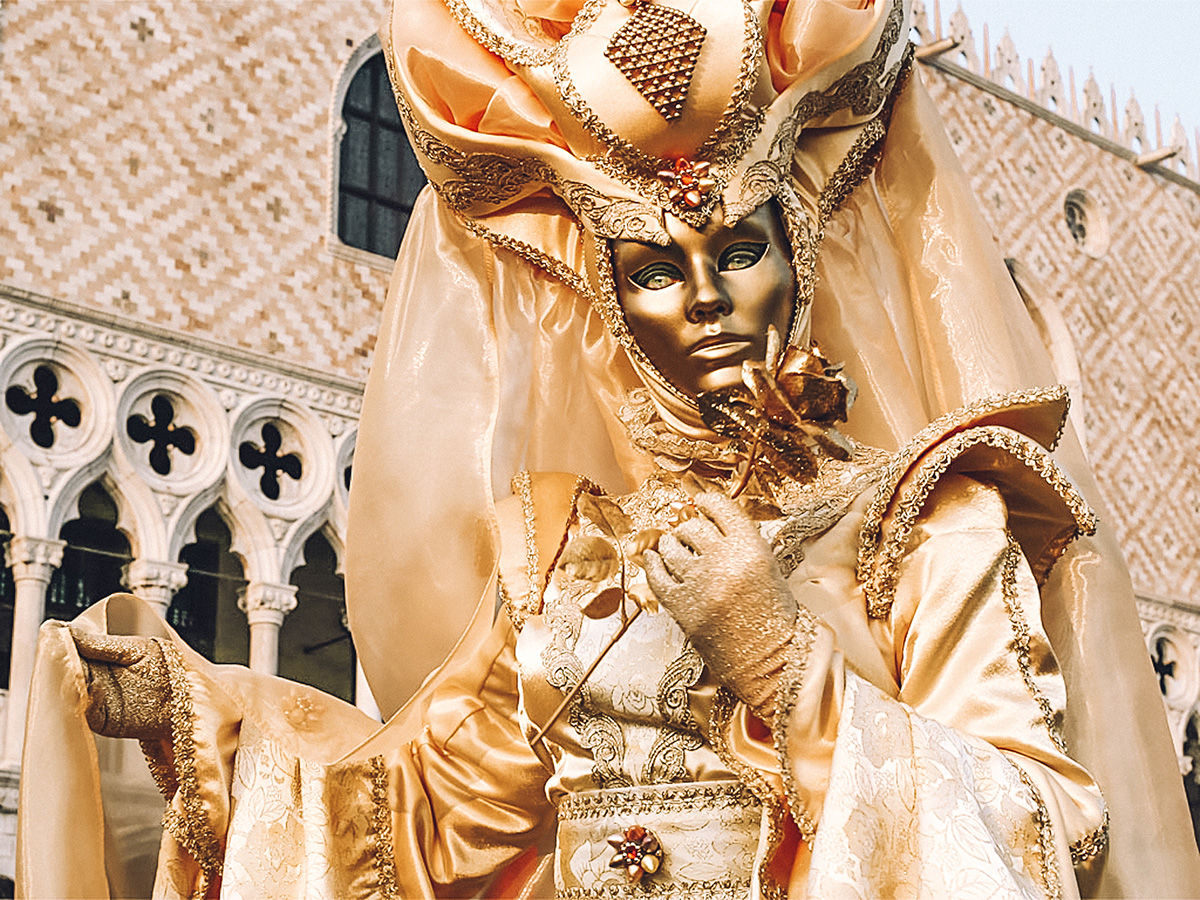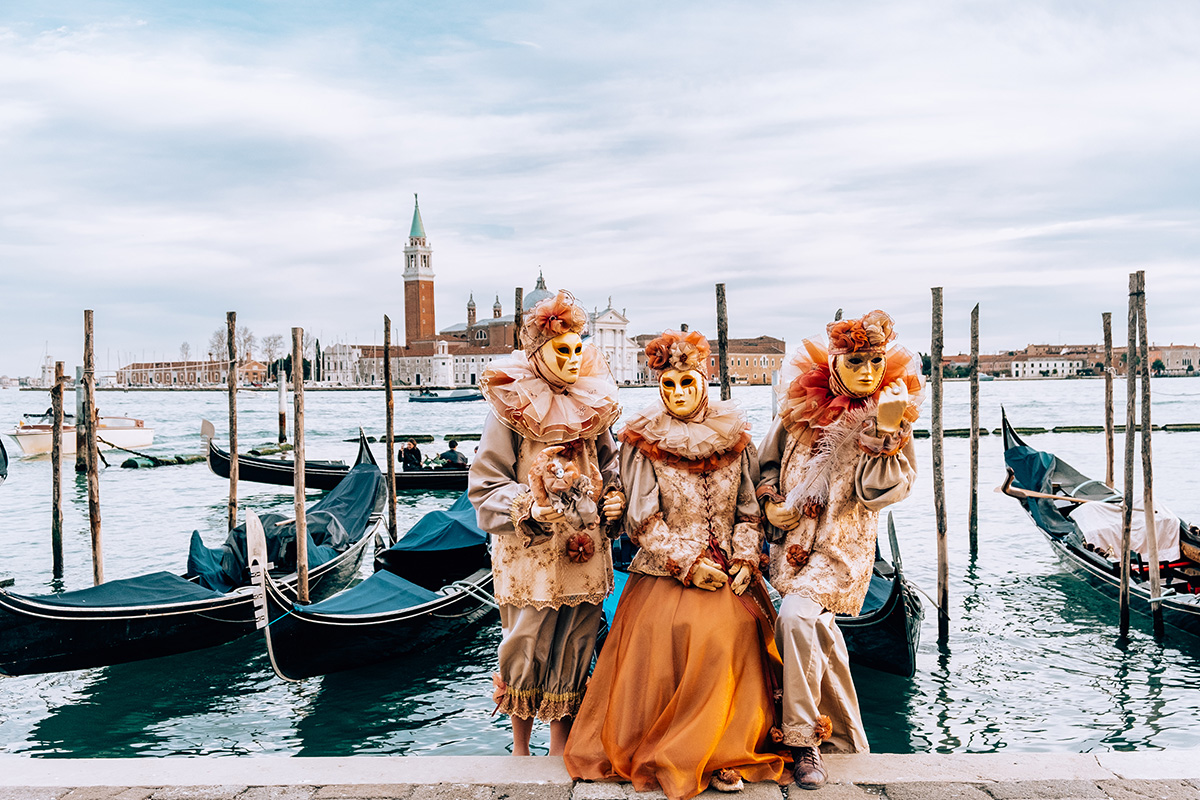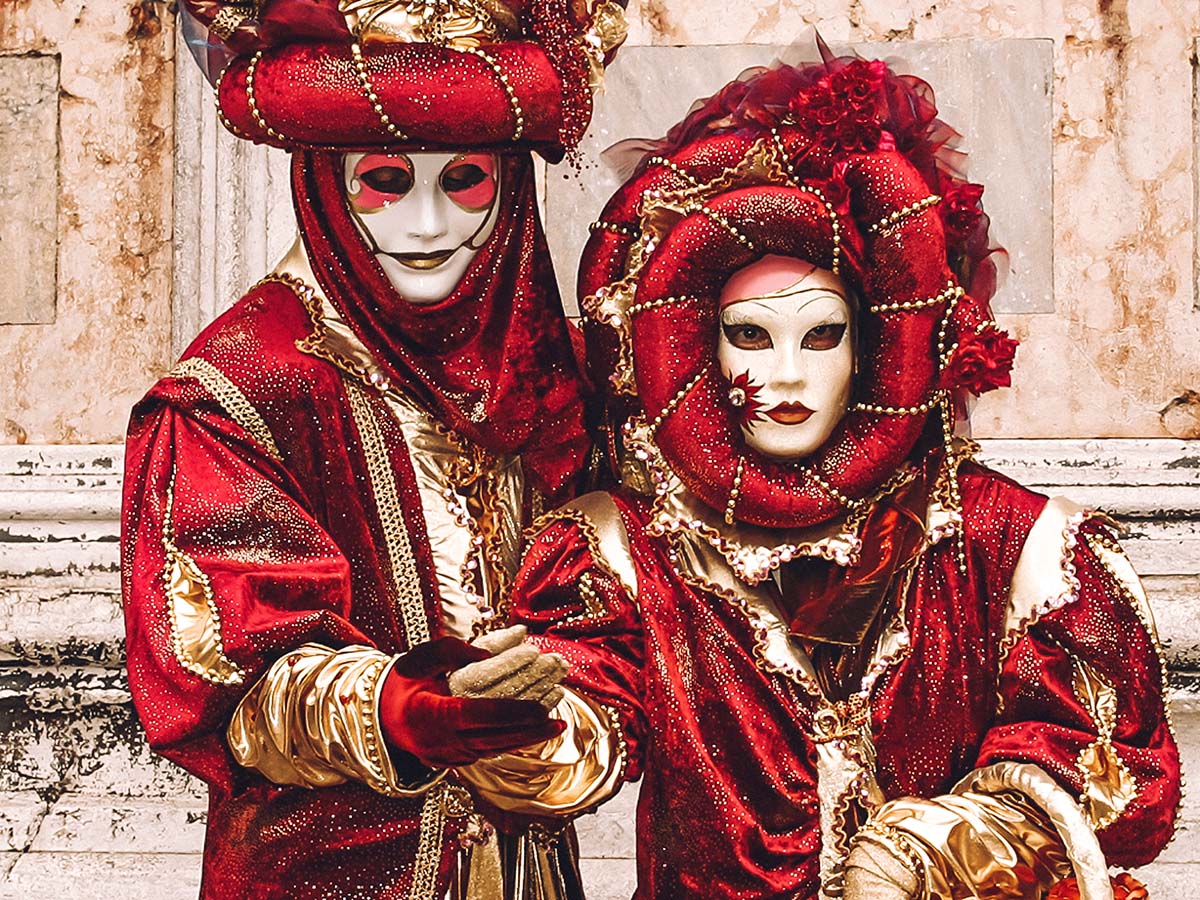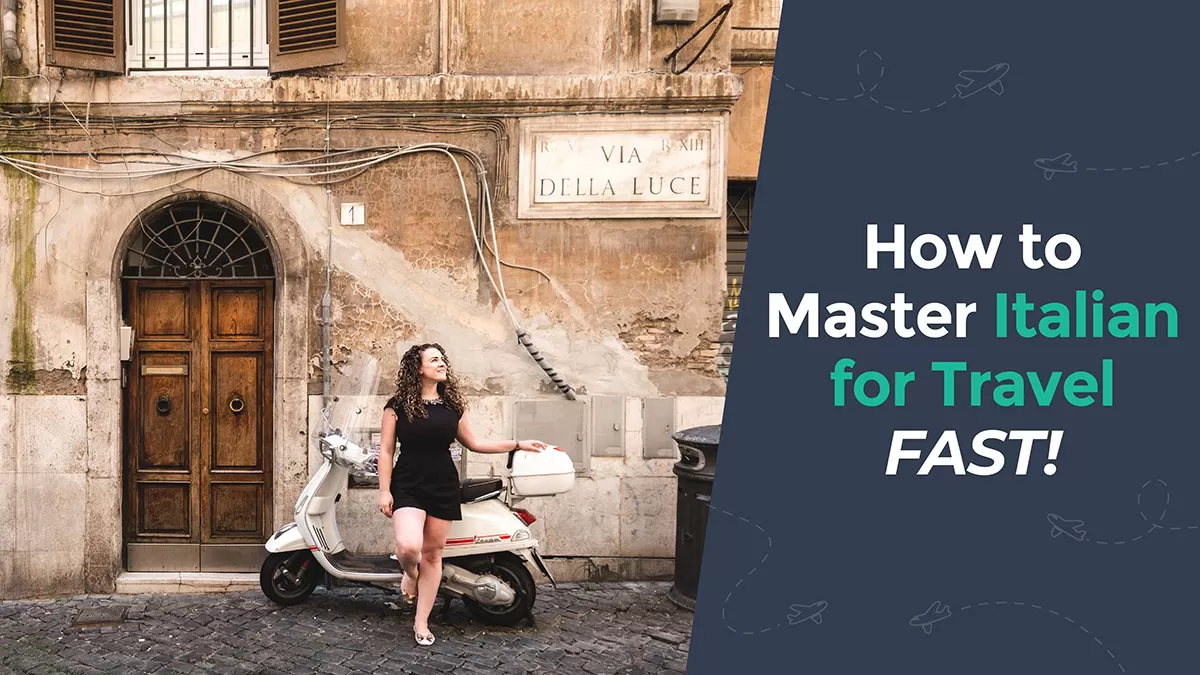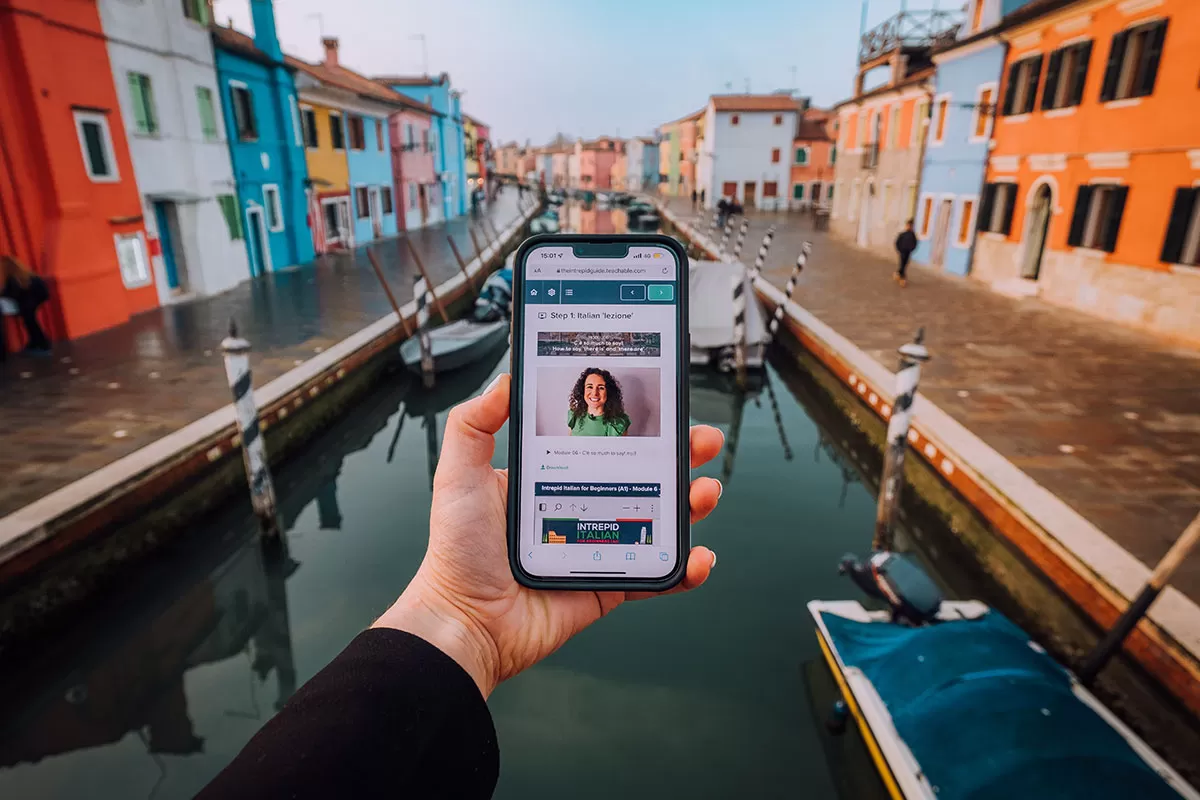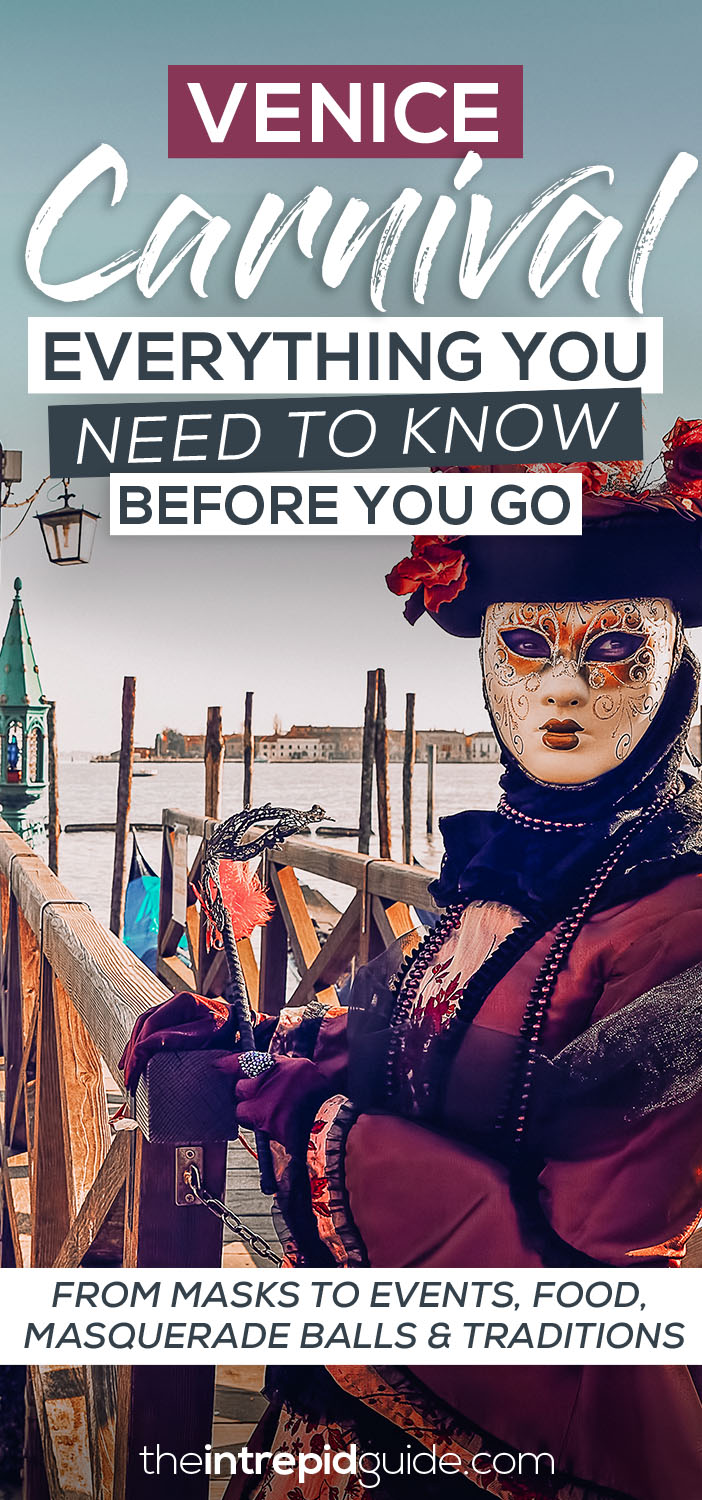The Venice Carnival is one of the brightest events in the world that even children know about. Every year, the procession brings together thousands of people who want to plunge into the special atmosphere of the holiday. For 2 weeks, Venice turns into a fairy tale, descended from the pages of your favorite books.
History of the holiday
The Venetian Carnival has its origins in ancient Rome. Every year the Romans celebrated Saturnalia, a pagan remembrance of the god Saturn, the patron saint of agriculture. The celebration took place in December, the post-harvest time at the winter solstice. One of the translations of the word «carnival» is «ceremonial carriage», which confirms the origin of the festival during the period of pagan idolatry and the revival of inanimate objects.
And in chariots, people drove around the cities figures of idols, thanks to them or begging for fertility, deliverance from diseases, epidemics and cataclysms. The cabbies accompanying the chariots dressed as brightly and cheerfully as possible so that the idols had a good mood.
Why masks?
During the Saturnalia period, as today during the carnival, social statuses and regalia were erased, all estates became equal to each other — ordinary people had fun on a par with their masters. So that no one was embarrassed or afraid of the consequences of the carnival, people wore masks — in this case, the person did not know who was in front of him. Now masks decorate and compete, whose accessory is more beautiful, and in ancient Rome, all masks were equally faceless — again, to smooth out social inequality.
Later, already in Venice, the masks got another meaning: if a woman went on a spree until morning, and a man was carried away by a beautiful young lady, he covered himself with a mask and avoided gossip. The Venetians liked this so much that they began to wear masks outside the carnival. The secular and ecclesiastical authorities did not encourage this and issued a decree prohibiting wearing this accessory outside the carnival.
First carnival
There are 3 main hypotheses about how and when the first Venice Carnival took place:
- One of the main ones takes us to the beginning of the second millennium, at a time when trade cooperation between Byzantium and Venice was established — this union could be marked by large-scale festivities (1094)
- The second hypothesis was based on a story that happened a century earlier: the pirates took away the Venetian girls, but the suitors managed to save them and return them home — this is a joyful event and formed the basis of the carnival (998)
- The third version is the victory of the Venetians over the Patriarch Ulrico (1162).
The celebration was officially legalized in 1296. The Senate of Venice announced that from now on the last day before fasting (in Orthodoxy, by the way, this is Maslenitsa) will be the day of the carnival. From the very first years, the celebration was gaining scope and luxury. People did not recognize each other (even spouses), intrigues, seduction, coquetry, fun until you drop were allowed — there were no prohibitions!
The costumes, masks and events of the carnival reflected the history of Venice: for example, in 1571, after the victory of the Venetians over the Turks, people drew masks on Turkish themes, wore turbans or trousers.
Contemporary Venetian Carnival
The opening ceremony begins in one of the areas of Venice — Cannaregio. At 19:00, boats begin to sail along one of the canals, in which artists, musicians, acrobats and dancers demonstrate their skills. The procession is accompanied by music and lighting effects, while hungry spectators can sample Venetian cuisine.
During the carnival, which lasts 18 days, people participate in:
- Feast of Mary — a procession in which 12 girls in ancient costumes walk from the church of San Pietro di Castello to St. Mark’s Square, where the election of «Mary of the Year» will take place.
- Feast of all Venetians
- «Flight of the Angel»: a girl who has tried on the image of an angel descends the rope from the bell tower of St. Mark’s Square
- In Mestre (a suburb of Venice), a man dressed as a donkey flies from the window of the town hall
- Competitions for the best mask and costume
- Costumed nightly dinners and dances, etc.
Life hacks from experienced
- It is better to visit the carnival, which is held in the autumn-spring time, in the summer there is a real bathhouse
- Check out the schedule of events in advance
- During the festival, housing prices increase significantly. Try to settle in Mestre — a suburb of Venice: you will have to spend more time on the road, but you will be able to save significantly
- Better to choose an apartment with a kitchen to save money on restaurants too
- Do not hesitate to take pictures with passers-by in fancy costumes — they only welcome this
- Walk as much as possible and try to attend as many events as possible!

Many colorful events are held on the streets of Venice during the Carnival. Street musicians, theater and circus artists perform in many places of the city. Artists and musicians from many countries come to the carnival. You will find a lot of people in carnival costumes and masks these days on the streets of Venice. As a rule, they are happy to pose for tourists (you can make beautiful pictures) for free. Many tourists also buy a mask and become the carnival participants.
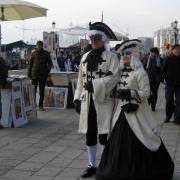
Some tourists believe that the time of the carnival is not the best time for sightseeing in Venice. The streets of Venice can be very crowded these days. Winter weather can be cool. The best solution is to come to Venice twice: at the festival and at other times of the year.
- The next carnival in Venice will take place from 4 to 22 February 2023.
- Venice Carnival 2022 was held from from February 12 to March 01.
For more information about Venice Carnival 2022 please visit this page.
The first documentary mention of the carnival in Venice belongs to 1094. However, the carnival traditions have much more ancient history and have their roots in pagan celebrations. It is believed that carnival was held annually from 1162. In 1296 Carnival was declared a public holiday. In the Middle Ages, carnival lasted six weeks, starting on December 26.
At that time, during the carnival, in some sense the line between the higher and lower classes was blurred. People could afford what was unacceptable in another time under the cover of the masks (once a year, it is acceptable to have no brakes). But the masks were used also by criminals, and there was constant struggle against it.
In the XVIII century the Venetian Carnival fell into decline and was almost forgotten for many years.
The carnival revival began in the late 20th century. Since 1979, the Venice Carnival is one of the brightest events in Italy. The Italian Government and the Municipality of Venice use carnival to attract tourists.
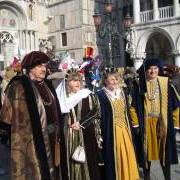
Also the so-called Angel Flight is also performed at the first Sunday of the carnival at noon at St. Mark’s Square. Dressed in a beautiful costume girl goes down on a rope from the tower to the Piazza San Marco.
You can come here with own costume or buy ready-made mask on the street in Venice (prices start at 5 euros).
There are several types of traditional Venetian masks:
- “Bauta” is white mask covering whole face. It is usually worn with a black cloak. The mask used by both by men and women.
- “Columbine” is a female mask (half-mask), decorated with feathers.
- “Moretti” is a black velvet oval female mask. The mask kept by mouth (for specialized package detail). A woman in a mask could not speak.
- “Cat” (Gatto) is mask depicting cats.
- “Doctor” (Doctor of the Plague, Medico della Peste). Earlier this mask was worn only by doctors during the plague.
Every men lie but if you give them a mask they will be sincere. (Oscar Wilde.)
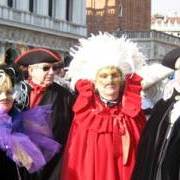
This page has photos taken during my visit to Venice in February 2013.
Read more about Italy, about Rome, about popular tourist destinations in Europe. See also: tourist map of the world.
Walking through the streets and squares of Venice and just watching what’s happening is not the best way to spend time during the carnival. It will be much more exciting to put on a carnival costume, mask and become one of the participants of the carnival. You will get unforgettable emotions, memories and photos. Carnival costume or mask you can buy, rent, or even do it yourself. Information about one of the company of costumes and masks.
Useful links:
- Hotels in Venice — you can choose and book it online. It is better to do in advance at carnival days.
- Hotel searching and booking can be done easily online. You can get information about the prices and availability of rooms.
- Map of Venice can be useful if you are planning a trip to Venice.
- You can also buy a plane ticket in the Internet. We propose to compare two online ticketing systems.
- Choose and book a guided tour in Venice.
Carnival (or “Carnevale”) is one of the biggest celebrations in Italy – and from Venetian masks to masquerade balls, no place does it like Venice! Like the idea of seeing the city at its most festive and colorful? Here’s a handy Q&A about Carnevale in Venice!
When is Venice’s Carnevale?
Carnevale in Venice, as with Carnival around the world, takes place in the days leading up to Lent. In 2013, it runs from January 26 to February 12.
Where did the idea of Carnevale come from?
During the 40 days of Lent, parties were off-limits—and so was eating foods like meat, sugar, and fats. As a result, people would try to get rid of all of their rich food and drink (and get their partying out of the way!) before Lent. Hence… Carnival. (In fact, the word Carnevale may come from the Latin words carne and vale, meaning “farewell to meat”!). According to Venetian tradition, Venice’s Carnival got its start in 1162, when townspeople celebrated a victory over the Patriarch of Aquileia. Festivities became The festival declined during the 18th century. By the 16th century, Venetians were celebrating Carnevale in style!
What about Venetian masks?
Pietro Longhi’s “The Ridotto,” showing the commonplace use of masks 1750s Venice
The tradition of masking has a long tradition in Venice. All the way back in 1268, a law even was passed to ban – of all things – putting on masks and throwing perfumed eggs!
By the time of the Renaissance, masks were a fixture of Carnevale celebrations. By the 16th century, the popular Commedia d’Arte troupe performed slapstick comedy in the piazzas of Venice—while masked. Believe it or not, though, masking was hardly just a Carnival tradition.
By the 18th century, Venetians were allowed to wear masks for six months a year. And they took advantage! Black velvet masks, for example, would be worn in “houses of ill repute”—especially gambling parlors—to shield their owners’ identities, as shown in the painting here.
Don’t miss our video on mask-making in Venice today, below!
So… you’re saying Carnevale in Venice has been celebrated non-stop since the 13th century?
Not quite. By the 18th century, Venice’s Carnevale festivities were going downhill. With the Austrian conquest of Venice in 1798, mask-wearing—as well as Carnevale—were all but finished. In the 1930s, Mussolini banned the celebrations altogether.
So what changed? In 1979, a group of Venetian artisans banned together to restart Carnevale. If that seems like a ploy for tourism, it was—and it was one that worked. Today, about 3 million people travel to Venice every year for Carnevale. The 1970s are also when the long-forgotten art of mask-making was restarted.
What is Venice’s Carnevale like today?
Today, Carnevale in Venice is a huge celebration that goes on for two weeks. While many events—particularly the opulent masquerade balls—require invitations and have steep ticket prices, many others, like the candle-lit parade of boats, concerts, and street performances, are free and open to the public.
Well, bummer. I’m not going to be in Venice during Carnevale. Can I get in on the fun anyway?
Of course—at least when it comes to those Venetian masks! Just be aware that the majority of mask shops in Venice sell cheap, imported masks, a far cry from the artisanal tradition that Venetian mask-making truly is. So do yourself, and the artisans of Venice, a favor, and choose your mask shop carefully. Need help? Here are some of our favorite mask shops in Venice (several of which even run mask-making workshops; check their websites for more!):
A Venetian mask shop in Venice
Benor Maschere Venezia (Santa Croce): Hidden behind Campo San Giacomo dell’Orio, this artisanal mask shop boasts a gorgeous collection, all made there in the workshop. Tel.: +39 041710033. Address: S. Croce 1109.
Ca’ Macana (Dorsoduro): This Venetian mask shop, located just off Camp San Barnaba, has an unparalleled selection of Carnevale masks; better yet, they’re handcrafted in the workshop right there, and you can watch them being made. Tel.: +39 0412776142. Address: Dorsoduro 3172.
Ca’ del Sol Maschere (San Marco): Artisans handcraft the Venetian masks at this shop a 5-minute walk from St. Mark’s Basilica; exquisite Carnevale costumes are on sale here, too. Tel.: +39 0415285549. Address: Castello 4964.
Il Canovaccio (Castello): The artisans here create Venetian masks and papier-mâché objects meant for the stage. Tel.: +39 0415210393. Address: Castello 5369.
Happy Carnevale!
- Art
- Culture
- Events
- Festivals
- Traditions
- Venice
- Winter
Festival
Фестиваль
There are hundreds of
festivals taking place every month all over the world. They are often
connected with celebrations of certain holidays, for example, New Year
Day, St. Patrick’s Day, Shrove Tuesday, Mother’s Day, May Day,
Children’s Day, Halloween, etc. There are also some festivals, which are
not connected with common holidays, but are cheerfully celebrated in
certain countries. For example, Songkran – Thai New Year, La Tomatina,
Oktoberfest, Glastonbury Festival, Guy Fawkes Night, Notting Hill
Carnival, Holi. I think that everyone enjoys participating in such
festivals. As for me, I would love to see the Notting Hill Carnival and
Holi. These two festivals are so different from the ones we celebrate
each year. The Notting Hill Carnival is a street carnival, which takes
place in England in late August. It is named after the London district,
where it’s held. This festival has been celebrated since 1966 and it is
considered to be the inspiration of black immigrants. The Notting Hill
Carnival lasts for several days and is attended by more than two million
people every year. The participants wear shimmering costumes, sing
Calipso songs, play drum music, and present group dancing. Perhaps, the
most inviting part during the festival is the tasting of exotic food.
Holi is another festival I’d like to visit. It’s a spring festival,
which marks the abundance of wheat harvest. It has originated in India
and is celebrated for a couple of days. The main idea of the festival is
to show the triumph of virtue over evil through bright colors. The
participants are seen singing and dancing in small groups. They also
throw colors at each other. On this day people stop any quarrels,
forgive each other and with good luck.
The first mention of the carnival in Venice belongs to
1094, although the XIII—XIV centuries masks on carnivals did not
wear. In 1162 to celebrate the victory over the Patriarch of
Aquileia began the festivities at the Piazza San Marco. Presumably
since that time, the carnival became an annual event. In 1690-ies of the
Stolnik P. A. Tolstoy left the following description of the
carnival(на русском-Первое упоминание карнавала в Венеции относится к 1094 году,
хотя до XIII—XIV веков масок на карнавалах не носили. В 1162 году в
честь победы над патриархом Аквилеи началось народное гуляние на
площади Сан-Марко. Предположительно с того времени карнавал стал
ежегодным. В 1690-е годы стольник П. А. Толстой оставил следующее
описание карнавала)
| Carnival of Venice
Carnevale di Venezia |
|
|---|---|

The Venetian carnival tradition is most famous for its distinctive masks |
|
| Status | Active |
| Genre | Carnival |
| Frequency | Annually |
| Location(s) | Venice |
| Country | Italy |
| Inaugurated | 1979 (modern event) |
| Founder | City of Venice |
| Attendance | Up to 3 million |
The Carnival of Venice (Italian: Carnevale di Venezia) is an annual festival held in Venice, Italy. The carnival ends on Shrove Tuesday (Martedì Grasso or Mardi Gras), which is the day before the start of Lent on Ash Wednesday. The festival is world famous for its elaborate masks.
History[edit]
According to legend, the Carnival of Venice began after the military victory of the Venetian Republic over the Patriarch of Aquileia, Ulrico di Treven in the year 1162. In honour of this victory, the people started to dance and gather in San Marco Square. Apparently, this festival started in that period and became official during the Renaissance.[1] In the seventeenth century, the baroque carnival preserved the prestigious image of Venice in the world.[2] It was very famous during the eighteenth century.[3] It encouraged licence and pleasure, but it was also used to protect Venetians from present and future anguish.[4] However, under the rule of the Holy Roman Emperor and later Emperor of Austria, Francis II, the festival was outlawed entirely in 1797 and the use of masks became strictly forbidden. It reappeared gradually in the nineteenth century, but only for short periods and above all for private feasts, where it became an occasion for artistic creations.[5]
After a long absence, the Carnival returned in 1979.[6] The Italian government decided to bring back the history and culture of Venice and sought to use the traditional Carnival as the centrepiece of its efforts. The redevelopment of the masks began as the pursuit of some Venetian college students for the tourist trade. Since then, approximately 3 million visitors have been coming to Venice every year for the Carnival.[7] One of the most important events is the contest for la maschera più bella («the most beautiful mask»), which is judged by a panel of international costume and fashion designers. Since 2007 the winners have been:
- 2007: La Montgolfiera by Tanja Schulz-Hess
- 2008: Luna park by Tanja Schulz-Hess
- 2009: The voyages of Marco Polo by Horst Raack and Tanja Schulz-Hess
- 2010: Pantegane from England
- 2011: La famille Fabergé by Horst Raack, and Ommagio a Venezia by Paolo and Cinzia Pagliasso and Anna Rotonaia, best costume for the official theme 19th century by Lea Luongsoredju and Roudi Verbaanderd
- 2012: Il servizio da thè del settecento (teatime) by Horst Raack, most creative costume Oceano by Jacqueline Spieweg
- 2013: Alla Ricerca del Tempo Perduto by Anna Marconi, most colourful costume Luna Park
- 2014: Una giornata in campagna by Horst Raack, and Radice Madre by Maria Roan di Villavera
- 2015: Le stelle dell’amore by Horst Raack, best costume for the official theme La regina della cucina veneziana by Tanja Schulz-Hess, most creative costume Monsieur Sofa et Madame Coco by Lorenzo Marconi
- 2016: I bagnanti di Senegalia by Anna and Lorenzo Marconi, best costume for the official theme I caretti siciliani by Salvatore Occhipinti and Gugliemo Miceli
- 2017: Il signore del bosco by Luigi di Como
- 2018: L’amore al tempo del campari by Paolo Brando
- 2019: I bambini della luce by Horst Raack, best traditional costume matrimonio all’ Italiana by Borboni si Nasce, most original costume Paguri by Nicola Pignoli and Ilaria Cavalli
In February 2020, the Governor of Veneto Luca Zaia announced the decision to call off the Carnival celebrations in an attempt to contain the spread of the coronavirus disease.[8]
Carnival masks[edit]
Masks have always been an important feature of the Venetian carnival. Traditionally people were allowed to wear them between the festival of Santo Stefano (St. Stephen’s Day, December 26) and the end of the carnival season at midnight of Shrove Tuesday (movable, but during February or early March). As masks were also allowed on Ascension and from October 5 to Christmas, people could spend a large portion of the year in disguise.
Maskmakers (mascherari) enjoyed a special position in society, with their own laws and their own guild, with their own statute dated 10 April 1436. Mascherari belonged to the fringe of painters and were helped in their task by sign-painters who drew faces onto plaster in a range of different shapes and paying extreme attention to detail.
Venetian masks can be made of leather or porcelain, or by using the original glass technique. The original masks were rather simple in design, decoration, and often had a symbolic and practical function. Nowadays, most Italian masks are made with the application of gesso and gold leaf and are hand-painted using natural feathers and gems to decorate.[citation needed] However, this makes them rather expensive when compared to the widespread, low-quality masks produced mainly by American factories.[citation needed] This competition accelerates the decline of this historical craftsmanship peculiar to the city of Venice.
Several distinct styles of mask are worn in the Venice Carnival, some with identifying names.[9] People with different occupations wore different masks.[10]
Origin[edit]
There is less evidence explaining the motive for the earliest mask being worn in Venice. One scholar argues that covering the face in public was a uniquely Venetian response to one of the most rigid class hierarchies in European history.[11] During Carnival, the sumptuary laws were suspended, and people could dress as they liked, instead of according to the rules that were set down in law for their profession and social class.[12]
Masked men threw eggshells filled with perfume during carnival.
The first documented sources mentioning the use of masks in Venice can be found as far back as the 13th century.[13] The Great Council made it a crime for masked people to throw scented eggs.[14] These ovi odoriferi were eggshells that were usually filled with rose water perfume, and tossed by young men at their friends or at young women they admired.[12] However, in some cases, the eggs were filled with ink or other damaging substances.[12] Gambling in public was normally illegal, except during Carnival;[12] the Great Council document decrees that masked persons were forbidden to gamble.[15]
Another law in 1339 forbade Venetians from wearing vulgar disguises and visiting convents while masked. The law also prohibited painting one’s face, or wearing false beards or wigs.[13]
Near the end of the Republic, the wearing of the masks in daily life was severely restricted. By the 18th century, it was limited only to about three months from December 26. The masks were traditionally worn with decorative beads matching in colour.
Bauta[edit]
Simple bauta mask with black zendale and tricorne; in background, zanni or pantalone mask
‘Woman of the Bautta’ Alessandro Longhi, circa. late 1700s. She is not actually wearing a mask.
Conversation of the masks, by Pietro Longhi, detail. A man and a woman, both wearing bauta: bauta masks, black tricorn hats, grey tabarros, and black zendales.
A man and a woman in bauta masks. The women’s mouth is just visible under the beak of the mask
The bauta (sometimes referred as baùtta) is a mask, today often heavily gilded though originally simple stark white, which is designed to comfortably cover the entire face; this traditional grotesque piece of art was characterized by the inclusion of an over-prominent nose, a thick supraorbital ridge, a projecting «chin line», and no mouth. The mask’s beak-like chin is designed to enable the wearer to talk, eat, and drink without having to remove it, thereby preserving the wearer’s anonymity. The bauta was often accompanied by a red or black cape and a tricorn.
In the 18th century, together with a black circular or semicircular clasped cape[16][17] called a tabarro (and zendale hood[18]) the bauta had become a standardized society mask and disguise regulated by the Venetian government.[19] It was obligatory to wear it at certain political decision-making events when all citizens were required to act anonymously as peers. Only citizens (i.e., men) had the right to use the bauta. Its role was similar to the anonymizing processes invented to guarantee general, direct, free, equal and secret ballots in modern democracies. Also, the bearing of weapons along with the mask was specifically prohibited by law and enforceable by the Venetian police.
Given this history and its grotesque design elements, the bauta was usually worn by men, but many paintings done in the 18th century also depict women wearing this mask and tricorn hat. The Ridotto and The Perfume Seller by Pietro Longhi are two examples of this from the 1750s.
Colombina[edit]
The Colombina (also known as Columbine and as a Colombino) is a half-mask, only covering the wearer’s eyes, nose, and upper cheeks. It is often highly decorated with gold, silver, crystals, and feathers. It is held up to the face by a baton or is tied with ribbon as with most other Venetian masks. The Colombina mask is named after a stock character in the Commedia dell’arte: Colombina was a maidservant and soubrette who was an adored part of the Italian theatre for generations. It is said it was designed for an actress because she did not wish to have her beautiful face covered completely. In fact, the Colombina is entirely a modern creation. There are no historic paintings depicting its use on the stage or in social life.
While both men and women now wear this mask, it began as a woman’s analog to the bauta.
Medico Della Peste (The Plague Doctor)[edit]
A Medico della Peste mask.
The Medico della peste, with its long beak, is one of the most bizarre and recognizable of the Venetian masks, though it did not start out as carnival mask at all but as a method of preventing the spread of disease. The striking design originates from 17th-century French physician Charles de Lorme who adopted the mask together with other sanitary precautions while treating plague victims.[20] The mask is often white, consisting of a hollow beak and round eyeholes covered with crystal discs, creating a bespectacled effect. Its use as a carnival mask is entirely a modern convention, and today these masks are often much more decorative. Although the mask and costume is worn almost exclusively by males, the enhancement in decoration also suggests that women are now more likely to wear the mask and costume than in previous years at the Carnival.
The plague doctors who followed De Lorme’s example wore the usual black hat and long black cloak as well as the mask, white gloves and a staff (so as to be able to move patients without having to come into physical contact with them). They hoped these precautions would prevent them contracting the disease. The mask was originally beaked with a purpose in congruence with the miasmatic theory of disease practiced at that time: the hollow beak allowed for the containment of flowers and other sweet-smelling substances designed to keep away the foul odors that were thought to spread infection. Those who wear the plague doctor mask often also wear the associated clothing of the plague doctor. The popularity of the Medico della peste among carnival celebrants can be seen as a memento mori.
Moretta/Servetta muta[edit]
Woman wearing a moretta, and another holding one, in Pietro Longhi’s The Rhinoceros
Closer view, in a 1745 portrait
The moretta (meaning dark one) or servetta muta (meaning mute servant woman) was a small strapless black velvet oval mask with wide eyeholes and no lips or mouth worn by patrician women. It derived from the visard mask invented in France in the sixteenth century, but differed in not having a hole to speak through. The mask was only just large enough to conceal a woman’s identity and was held in place by the wearer biting on a button or bit (the women wearing this mask were unable to speak, hence muta) and was often finished off with a veil. The Rhinoceros by Pietro Longhi, sometimes called Clara the rhinoceros, depicts this mask in use in 1751. It fell into disuse about 1760.
Volto (Larva)[edit]
The volto (Italian for face) or larva (meaning ghost in Latin) is the iconic modern Venetian mask: it is often made of stark white porcelain or thick plastic, though also frequently gilded and decorated, and is commonly worn with a tricorn and cloak. The «volto» is also quite heavier than a typical mask and has a much tighter fit; many people who experience claustrophobia do not wear the «volto» at the Carnival. If worn by a woman, who are the most common wearers of the volto at the modern festival, it is typically worn with a headdress, scarf, veil, another mask, or a combination of all four. It is secured in the back with a ribbon. Unlike the moretta muta, the volto covers the entire face of the wearer including the whole of the chin. Unlike a typical mask, it also extends farther back to just before the ears and upwards to the top of the forehead; also unlike the moretta muta, it depicts the nose and lips in simple facial expressions. Unlike the bauta, the volto cannot be worn while eating and drinking because the coverage of the chin and cheeks is too complete and tight (although the jaw on some original commedia masks was hinged, this is not a commedia mask and so is never hinged—the lips are always sealed).
Pantalone[edit]
Another classic character from the Italian stage, Pantalone, possibly stemming from the Italian «pianta il leone» referencing the conquests of Venice and the origin of this character, is usually represented as a sad old man with an oversized nose like the beak of a crow with high brows and slanted eyes (meant to signify intelligence on the stage). Like other commedia masks, Pantalone is also a half mask. This mask is almost exclusively worn by men, although its popularity at the modern festival has declined .[21]
Arlecchino[edit]
Arlecchino’s half-mask is painted black with an ape-like nose and a «bump» to signify a devil’s horn
Arlecchino, meaning harlequin in Italian, is a zanni character of the commedia. He is meant to be a kind of «noble savage», devoid of reason and full of emotion, a peasant, a servant, even a slave. His originally wooden and later leather half-mask painted black depicts him as having a short, blunt, ape-like nose, a set of wide, round, arching eyebrows, a rounded beard, and always a «bump» upon his forehead meant to signify a devil’s horn. He is a theatrical counterpoint to and often servant of Pantalone, and the two characters often appeared together on the stage.[21]
Zanni[edit]
A leather version of a Zanni mask, profile view
The Zanni class of characters is another classic of the stage. Theirs is a half mask in leather, presenting themselves with low forehead, bulging eyebrows and a long nose with a reverse curve towards the end. It is said that the longer the nose, the more stupid the character. The low forehead is also seen as a sign of stupidity.[21] The zanni are often the supporting characters in a commedia performance, often fulfilling similar societal roles as Arlecchino, though with smaller parts
In culture[edit]
The short story The Cask of Amontillado, written by Edgar Allan Poe, is set in Venice during the carnival.
Venetian masks feature prominently in the films Eyes Wide Shut and Marco Bellocchio’s The Witches’ Sabbath. Stores that supplied the masks include both Ca’ Macana[22] and Il Canovaccio[23] in Venice.
See also[edit]
- Masquerade ball
Images[edit]
-
Carnival of Venice 2020
-
Carnival of Venice 2020
-
Carnival of Venice 2020
-
Carnival of Venice 2020
-
Carnival of Venice 2020
-
Carnival of Venice 2020
-
Carnival of Venice 2020
-
Carnival of Venice 2020
-
Carnival of Venice 2020
-
Carnival of Venice 2020
-
Carnival of Venice 2020
-
-
-
-
-
-
-
-
-
-
-
-
-
-
-
-
-
References[edit]
- ^ Danilo Reato, Storia del carnivale di Venezia, Venezia, Assessorato alla Cultura della Provincia di Venezia, 1988.
- ^ Gilles Bertrand, Histoire du carnaval de Venise, XIe-XXIe siècle, Paris, Pigmalion, 2013, p. 37-94.
- ^ Stefania Bertelli, Il Carnivale di Venezia nel Settecento, Roma, Jouvence, 1992.
- ^ James H. Johnson, Venice incognito: masks in the Serene Republic, Berkeley: University of California Press, 2011; Gilles Bertrand, Histoire du carnaval de Venise, XIe-XXIe siècle, Paris, Pigmalion, p. 95-235.
- ^ Gilles Bertrand, Histoire du carnaval de Venise, XIe-XXIe siècle, Paris, Pigmalion, 2013, p. 237-310.
- ^ Alessandro Bressanello, Il carnivale in età moderna: 30 agni di carnivale a Venezia 1980-2010, Studio LT2, 2010; Fulvio Roiter, Carnaval de Venise, Lausanne, Payot, 1981.
- ^ Adams, William Lee (4 March 2014). «What’s with those mysterious masks? The dark drama of Venice Carnival». CNN.
- ^ Bruno and D’Emilio, Luca and Frances (23 February 2020). «Italy cancels Venice Carnival in bid to halt spread of virus». Associated Press.
- ^ Danilo Reato, Les masques de Venise, Paris, Hersher, 1991 (first published in italian, 1988)
- ^ «Venetian Masquerade Ball — Hawthorne Hotel». Hawthorne Hotel. Archived from the original on 2019-09-29. Retrieved 2017-08-18.
- ^ Johnson, James H. (2011). Venice incognito: masks in the serene republic. p. 54. ISBN 9780520267718.
- ^ a b c d Burke, Peter (2005-11-17). The Historical Anthropology of Early Modern Italy: Essays on Perception and Communication. Cambridge University Press. p. 186. ISBN 9780521023672.
- ^ a b Janet Sethre, The souls of Venice, 2003. Page 132.
- ^ Johnson, James H. (2011). Venice incognito: masks in the serene republic. p. 54. ISBN 9780520267718.
- ^ Ackroyd, Peter (2010-11-02). Venice: Pure City. ISBN 9780385531535.
- ^ «TABARRO: The Medieval Gentleman’s Cape». Baco. November 21, 2015.
- ^ «Tabarro». Tabarrificio Veneto.
- ^ «Magie di Carnevale». www.magiedicarnevale.com.
- ^ Ignatio Toscani: Die venezianische Gesellschaftsmaske. Ein Versuch zur Deutung ihrer Ausformung, ihrer Entstehungsgründe und ihrer Funktion. Diss. Saarbrücken 1970.
- ^ Christine M. Boeckl, Images of plague and pestilence: iconography and iconology (Truman State University Press, 2000), p. 27.
- ^ a b c Wiles, David (2004). The Masks of Menander: Sign and Meaning in Greek and Roman Performance. Cambridge University. p. 126. ISBN 9780521543521. Retrieved 27 April 2013.
- ^ See Pauline Frommer’s Italy by Keith Bain, Reid Bramblett, Pippa de Bruyn, William Fink, Barbie Latza Nadeau p. 333
- ^ Frommer’s Northern Italy: Including Venice, Milan & the Lakes by John Moretti p. 168
External links[edit]
- Official website
- Carnivalofvenice.com: History, photos and videos since 1998
- Carnival of Venice
The Intrepid Guide contains affiliate links. These commissions help reduce the ever-increasing costs of keeping this site active. Thanks for reading!
Every year 3 million people flock to the Laguna to admire and take part in Venice Carnival, an iconic event whose origins are centuries old. There’s nowhere else in the world where you can soak up a truly unique scenery consisting of extravagant masks and costumes parading in the squares and calli (typical narrow Venetian streets). The wearing of masks is an ancient tradition that gives Venice Carnival a characteristic and lively atmosphere. Being in Venice for Carnival is a once in a lifetime opportunity that can’t be missed.
In this guide, you’ll learn everything you need to know about the Carnevale di Venezia (Carnival of Venice), from its origins, history and development to its modern-day version, from the traditional food and masks to the dates where the main events take place around the city. To exercise your Italian skills, we’ll finish up with a list of essential Carnival vocabulary. Don’t miss my Italian travel phrase guide here.
Cominciamo! (Let’s get started!)
History and development
So, what exactly is Carnival? The term derives from the Latin carnem levare, literally “to eliminate meat” or carne vale, “farewell to meat”, both referring to the farewell to meat and all bodily pleasures which is celebrated with a great banquet on “Shrove Tuesday”, the day before Lent (a period of abstinence and fasting) begins.
Incidentally, this is also how we get the verb to incarnate (Italian: incarnare), literally to embody the spirit/flesh of another. When we escape our reality and slip on a mask and costume, we are actually incarnating another person.
Its etymology points to a Christian origin of this holiday period: it refers to the annual Christian feast that involves a public celebration of some kind, typically with parades, parties or other forms of entertainment. Lent lasts for forty days and ends at Easter.
The Carnival tradition has very ancient origins: back in the Roman times, for instance, the “Saturnali” were a time of year when a joyous collective ritual was permitted and even encouraged, in which the rigid order between social classes was subverted.
In ancient Greece, there were Dionysian cults with great religious festivals, processions and theatrical performances involving the use of masks and symbolic representations.
However, guess where the word ‘Carnival’ appears for the first time? Venice! In a document by Doge (the Venetian term for “general”) Vitale Falier in 1094, the word Carnival is used to refer to public entertainment.

Doge of Venice
It’s important to know that isn’t wasn’t until 1296 that the Carnival in Venice became an official public holiday after an edict of the Senate of the Republic declared the day before “Ash Wednesday” (the beginning of Lent) a public holiday.
The Dogiwere adept at promoting the Carnival to give the population, particularly the lower classes, a period of fun and celebration. Its intention was to act as an outlet for the tensions and ill feelings created by the strict rules imposed by the morality and public order of the Venetian Republic.
Thanks to the wearing of masks, total anonymity was guaranteed. This created a sort of cancellation of social divisions and a way to hide differences between noble people and peasants.
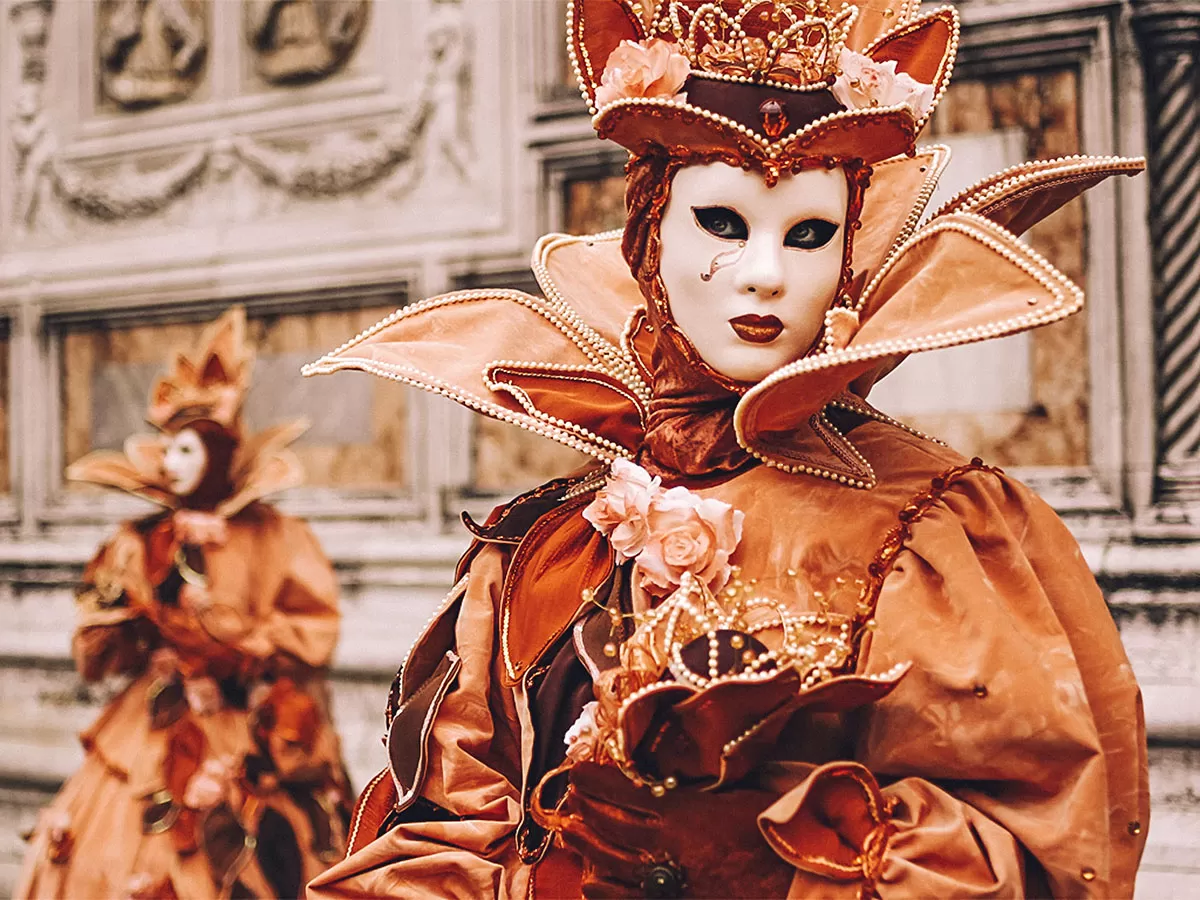
Unfortunately, the story of Carnival also has a sad chapter. In 1797 came the French invasion then later the Austrian occupation, together they ultimately put an end to not only Venice’s independence but also to Carnival. Celebrations were outlawed and the use of masks was strictly forbidden. Overall, this ban lasted for nearly 200 years! It wasn’t until 1979 that this ancient tradition was restored that can still be experienced today.
Don’t miss my Carnival guide below.
Venice Carnival today
Nowadays, Venice Carnival is back to being that hedonistic, prestigious celebration that it was when the Republic of Venice was the centre of the world, and one of Italy’s biggest events.
Venice Carnival runs for the two weeks leading up to Ash Wednesday. During this time a series of spectacular events such as masquerade balls, parties, parades, shows, and historical re-enactments take place in and around Venice.
An enchanted atmosphere fills the streets and squares of Venice and locals and visitors from all over the world dress up wearing elaborate costumes and masks. You can attend private parties, masquerade balls or simply watch the performances and the historical re-enactments in public squares and along the canals and be transported back in time.
Traditionally, the most important days of the Venetian Carnival are Shrove Thursday and Shrove Tuesday, although the largest crowds are recorded during the weekends.
Charm, enthusiasm and magnificence are the keywords of this unique and special event.
Once-in-a-lifetime Carnival Experience
To get the full Carnival experience, you can’t pass up attending il Gran Ballo Mascheranda. Set in a stunning 18th-century palace overlooking the Grand Canal, this costume-only event guarantees a night of pure escapism. Set in a decadent hall, you’ll enjoy an aperitif on arrival, a 3-course dinner, and various theatrical performances and dancing until late. This once in a lifetime event is hosted by none other than Casanova! Various tickets options are available as well as costume hire. Reserve your ticket here.
Typical Carnival sweets

And what is Carnival without enjoying the pleasure of culinary delights? Even in the early years of Carnival, street vendors would sell all kinds of merchandise, often exotic too. From seasonal fruit to spices, the people of Venice could savour foods from distant countries where Venice had large trade routes, especially from the East.
Even today, after the Christmas holidays, store windows and family dinner tables are filled with all sorts of Carnival sweets. As per these traditional recipes, frying was the main cooking method because it allows for large quantities to be prepared quickly. Among these, there are: frittelle, galani (or chiacchiere) and castagnole.
Frittella (a sort of fried pastry) is most certainly the undisputed queen of Carnival and has remained practically unchanged from its original recipe. The “frittella alla veneziana” (Venetian style) contains raisins, pine nuts and sugar, however, many variations have appeared on the market such as with cream and apple mousse.
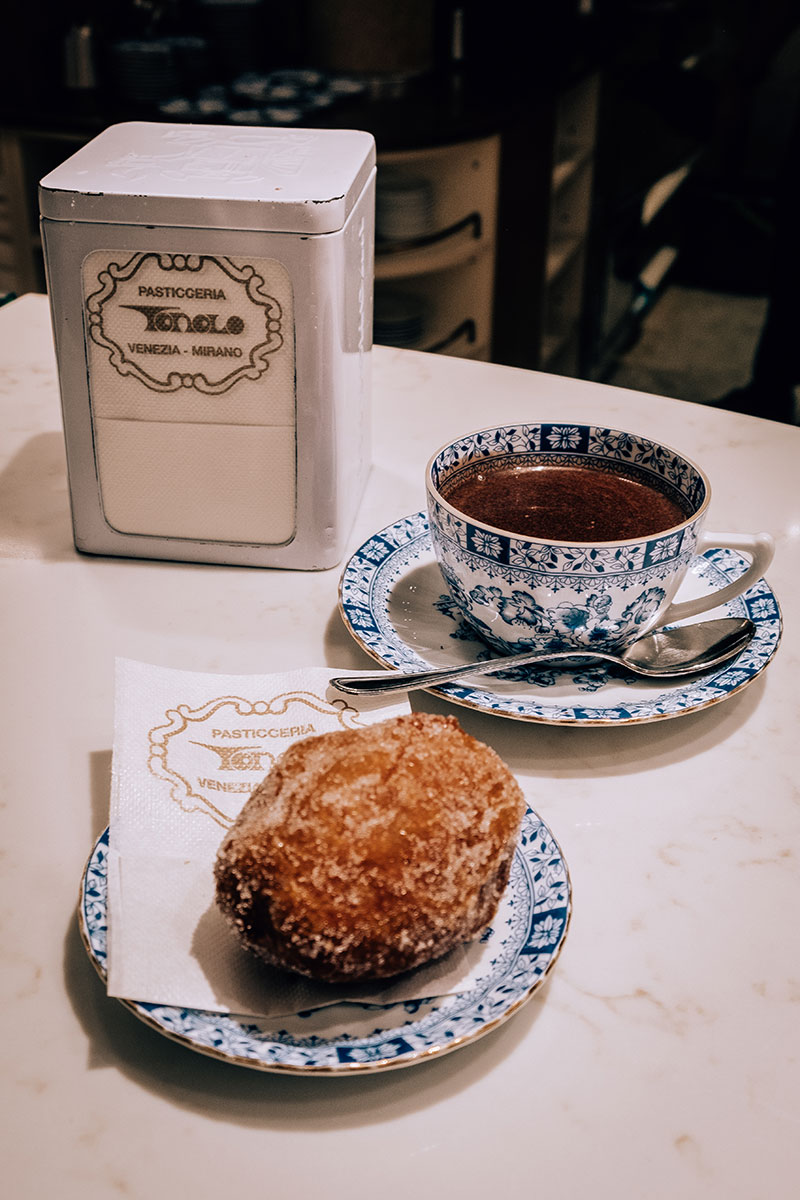
For the best Frittelle, visit Pasticceria Tonolo
Venice Carnival masks
Since its inception, wearing masks has been an essential feature and played an important role in Venice Carnival. Wearing masks was a way to hide personal identity, gender, social class and just become part of the Great Carnival Illusion in a place where anything can happen – where every glimpse never ceases to enchant.
Wearing masks was not just limited to Carnival but also worn on many other occasions during the year. For example, it was allowed on Stephen’s day during the fifteen days of the Ascension and for other important events of the Serenissima Republic.
During Carnival, Venetians would walk around the city wearing masks and greet others with a simple “Buongiorno, signora maschera!”.
To meet demand, mask production became a flourishing trade that soon became the hallmark of the city itself. To create Carnival masks, mascherari (mask makers) used all sorts of materials, from papier-mache, leather, porcelain to glass and decorated them with gems, feathers and fur. The very first ones were rather simple in design, style and decoration but over time they became more and more original, differentiating in many modern varieties and colours.
Among the most popular of Venice Carnival masks are the so-called Bauta masks, which cover the entire face but leave some space below for eating, drinking and talking. The Bauta was worn by both men and women. It is formed by a black veil or Tabarro, a black tricorn and a white mask.
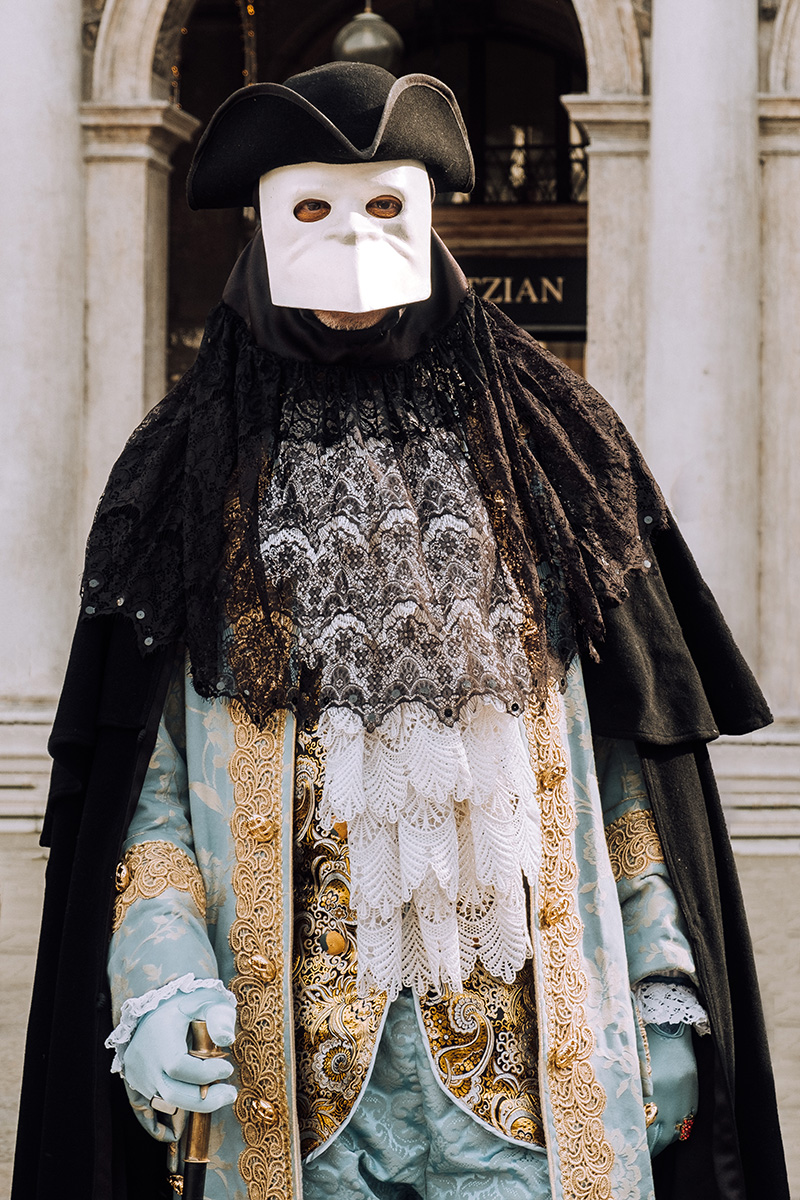
Bauta mask
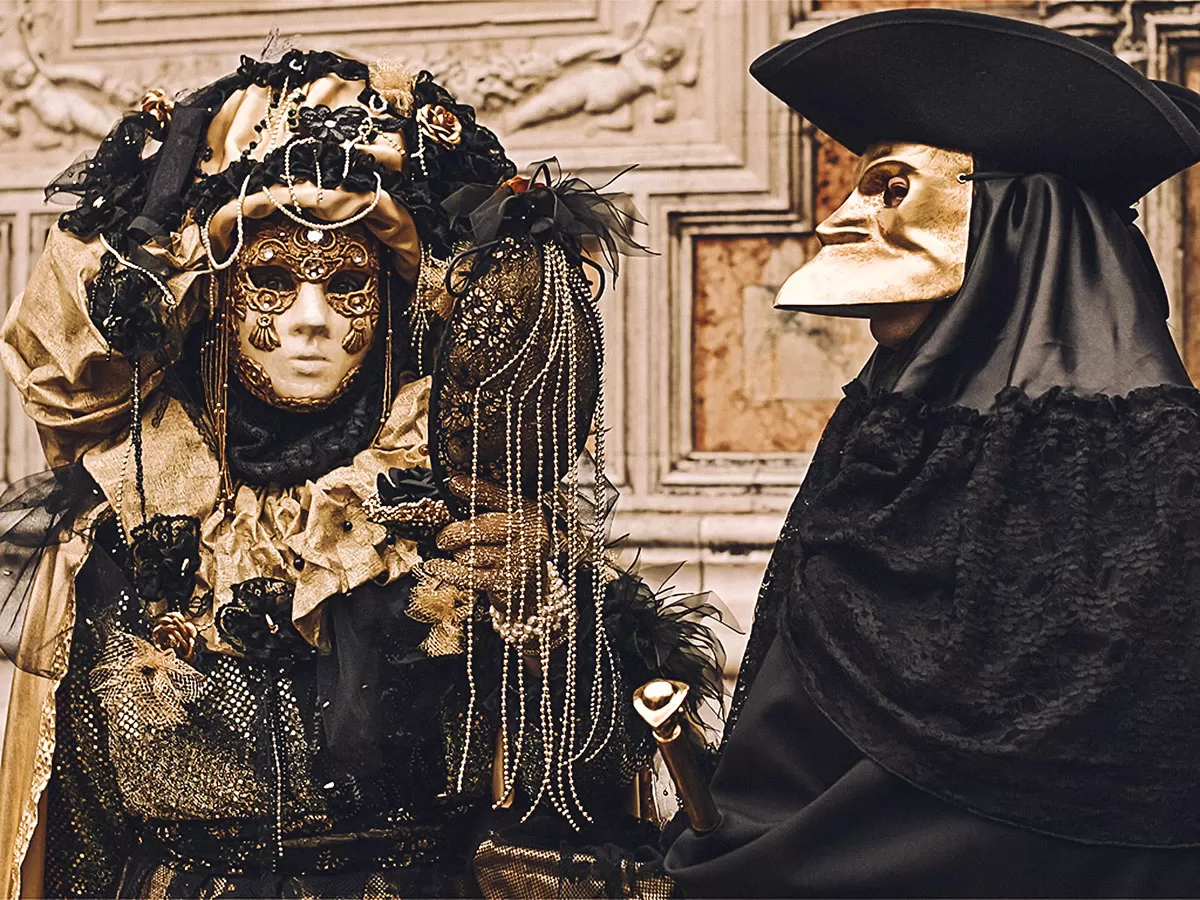
The Bauta Mask (right) is worn by both women and men
Another famous Venetian mask is the Moretta, an oval-shaped mask only worn by women. Made of dark velvet and worn with a veil, it was also called a “mute mask” since it was held in place by the mouth thanks to a small button inside.
The Volto mask is a plain white mask that covers the entire face and is often worn with a black hooded cape.
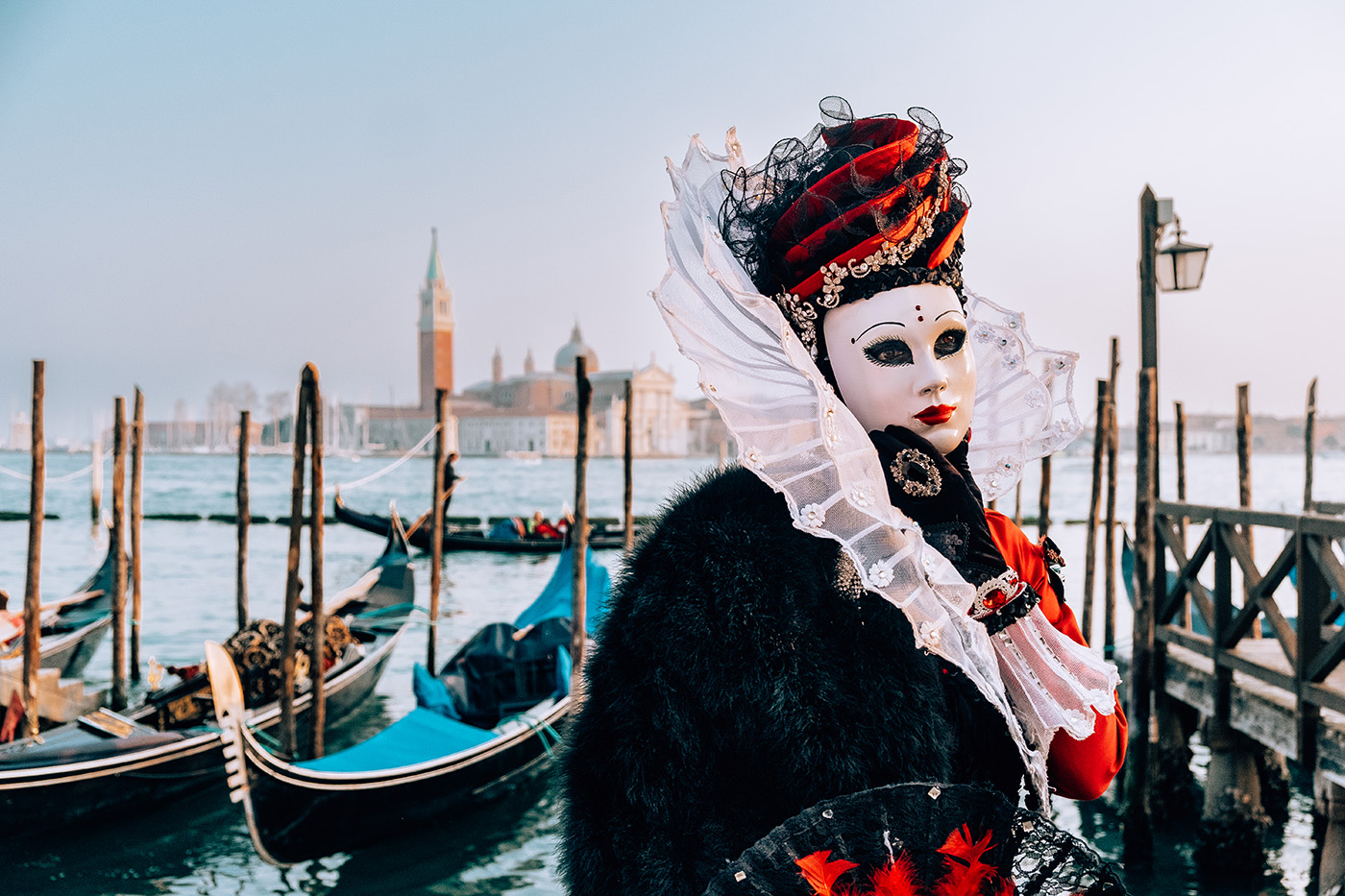
Volto mask
Other well-known masks and costumes are more colourful and festive and based on characters of the commedia dell’arte (first introduced by Carlo Goldoni in the 18th century) that speak of a past rich in inspiration and poetry. Among these include the greedy Pantalone (English: Pantaloon), the elegant Colombina (English: Columbine), and the colourful Arlecchino (English: Harlequin).
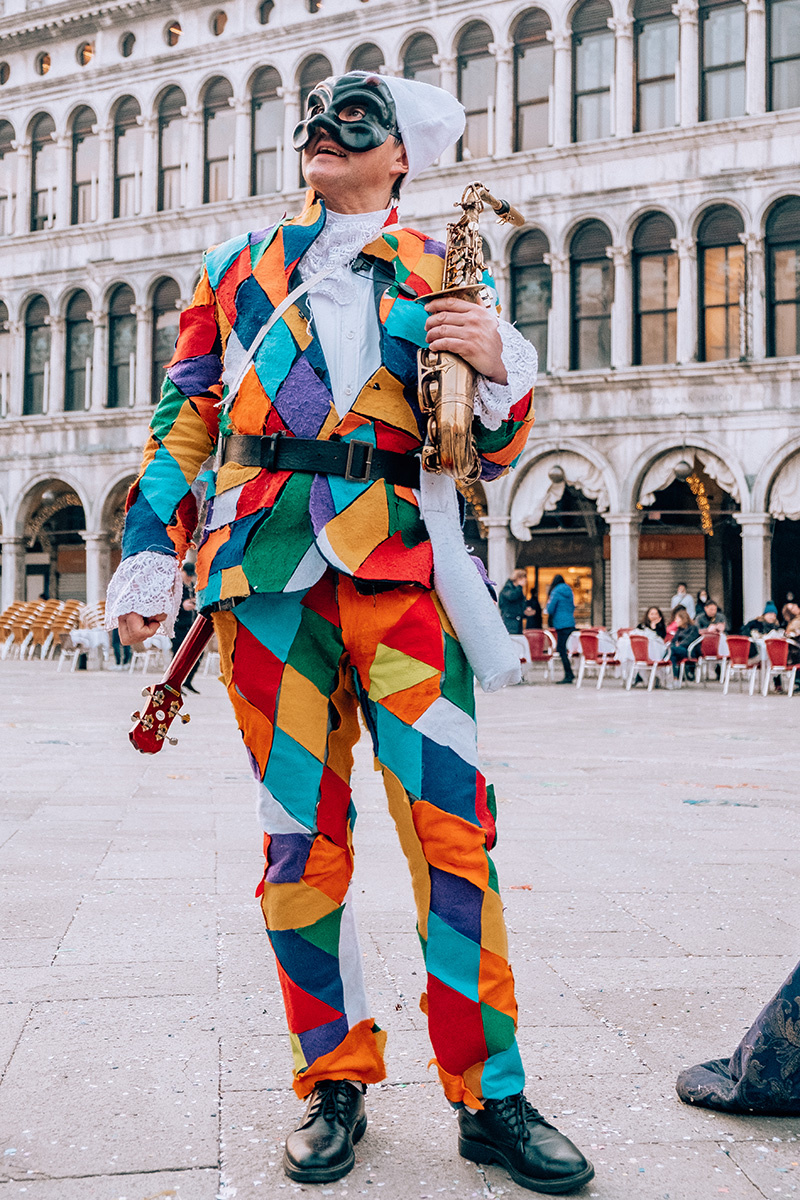
Harlequin costume from Commedia dell’Arte
Last but not least we have the infamous Plague Doctor. This unmistakable mask features a long-beak nose, glasses, a tunic made of either linen or waxed cloth and a stick to lift the clothes of plague victims.

Plague Doctor mask
The Plague struck the city of Venice on several occasions and the Plague Doctor mask was actually worn for practical necessity as its long nose contained a kind of filter composed of salts and herbal disinfectants like rosemary, garlic and juniper. Later on, this mask acquired a superstitious and exorcist meaning that repelled any contagious disease and therefore it was kept in the ritual of Carnival.
Venice Carnival Events
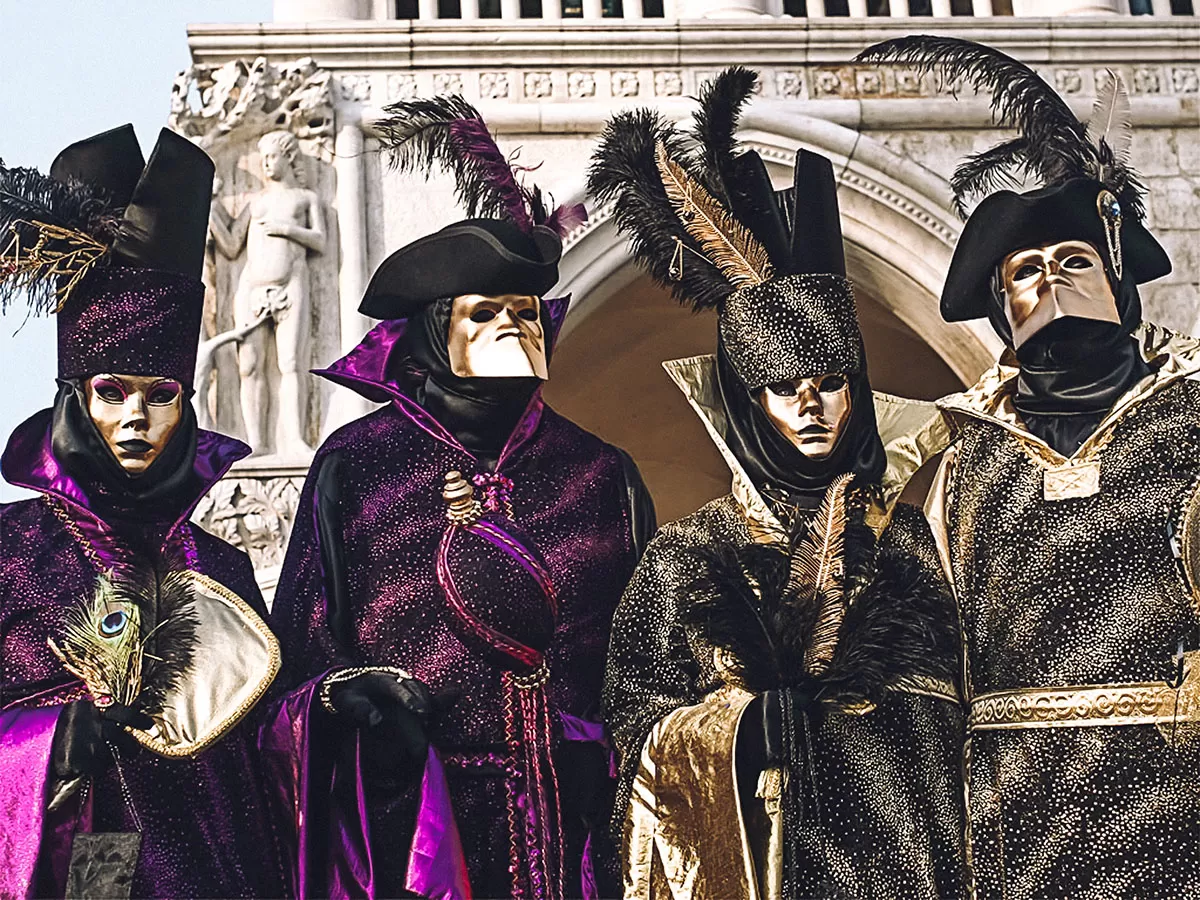
13th February 2022: Festa Veneziana sull’acqua
Event name: Festa Veneziana sull’acqua (Venetian Water Festival)
Location: Rio di Cannaregio, which was historically the main shipping canal in Venice.
To kick off Carnival, Festa Veneziana sull’acqua transforms this canal into a fantastic water stage putting on a spectacular show full of extravagante floating structures and acrobats performing impossible routines.
Located on the edge of Cannaregio (the most populated district of the city), this event is performed twice on the same day, once at 7 pm then again at 9 pm.
19th February 2022: Corteo e Festa delle Marie
Event name: Corteo e Festa delle Marie (Parade and Feast of the Marys)
Location: Via Garibaldi
The traditional ‘Festa delle Marie’ procession starts at San Piero di Castello at around 2.30 pm, continues along via Garibaldi and Riva degli Schiavoni before arriving on stage in Piazza San Marco around 4.00 pm, where the official presentation of Carnival takes place.
This historic re-enactment celebrates the Doge’s custom of giving gifts such as clothes and jewellery every year to 12 beautiful girls of humble origins, so that they would have a dowry when they get married.
In 973 AC, during one of these celebrations, Venice was attacked by pirates, and the brides were kidnapped along with their jewellery. They were miraculously saved and since then the city of Venice has made votive offerings to the Virgin Mary by officially establishing the Feast of the Marys.
Later on, carved wooden statues called ‘Marione’ replaced the actual girls and the festival lost much of its original meaning. In the following years, the celebration slowly fell into disuse and was suppressed in 1379. It wasn’t until 1999 that the modern celebrations of the ‘Festa delle Marie’ were re-established as a symbolic event.

Festa delle Marie
20th February 2022: Volo dell’Angelo
Event name: Volo dell’Angelo (Flight of the Angel)
Location: St. Mark’s Square
Like many other traditions, the Volo dell’Angelo was re-established after a long period of absence. During a Carnival in the mid-sixteenth century, a young Turkish acrobat managed to reach the belfry of St Mark’s bell tower by walking on a very long rope. Aided only by a barbell, he began his ascent on a rope that was tied to a boat anchored at the nearby pier.
The event, which was immediately named Svolo del turco (Fly of the Turk), aroused so much interest that the Venetians asked for it to be repeated in the following editions of Carnival. It usually took place on Shrove Thursday (while today it takes place on the second Sunday of the Carnival period), and underwent numerous variations over the years.
In 1759, the performance ended in tragedy where the acrobat plummeted to the ground amidst the horrified crowd. Due to the seriousness of this accident, the act of ascension by rope was banned. From then on, a large wooden dove (in Italian: “colomba”) was used in place of the acrobat. The dove released flowers and confetti onto the crowd as it flow from the bell tower. The “Volo dell’Angelo” (Flight of the Angel) then became the “Volo della Colombina” (Flight of the dove).
The original event has only very recently been revived. The first “modern” edition dates back to 2001. At first, the role of the “Angel” was entrusted to famous people in the field of sport or show business but since 2011 the task has been assigned to the winner of the previous year’s “Marie” competition.
27th February 2022: Il Volo dell’Aquila
Event name: Il Volo dell’Aquila (The Flight of the Eagle)
Location: St. Mark’s Square
Il Volo dell’Aquila is one of the most recent traditions of the Carnival of Venice. The Flight of the Eagle was established in 2012 in addition to the popular Flight of the Angel. During this event a similar aerobatic flight is performed by a prominent sports figure who soars over the festive crowds gathered in St Marks’ Square below.
Some of the previous editions included ice skaters Carolina Kostner and Arianna Fontana, the alpine skier Kristian Ghedina, and the Paralympic athlete and TV presenter Giusy Versace.
27th February 2022: Finale del concorso La Maschera Più Bella
Event name : Finale del concorso La Maschera Più Bella (Final of The Most Beautiful Mask contest)
Location: St. Mark’s Square
This contest is judged by a panel of international costume and fashion designers. For the 2021 edition, the winning masks included “La medichessa della Peste” (The Plague female Doctor), which best interprets the current period we are living in. During the whole Carnival period, every day the jury votes for the most beautiful masks and the winners will go directly to the final.
28th February 2022: Concorso La Maschera Più Bella – edizione per bambini
Event name: Concorso La Maschera Più Bella – edizione per bambini (The Most Beautiful Mask Contest – children’s edition)
Location: St. Mark’s Square
Similar to the adult version, this is a lovely event where children can actively participate in the festivities.
1st March 2022: Premiazione della Maria del Carnevale
Event name: Premiazione della Maria del Carnevale(Award ceremony of the Carnival Mary)
Location: St. Mark’s Square
On the last day of Carnival celebrations, there is an award ceremony that crowns the winning “Maria”. The event takes place after a water parade that starts at San Giacomo dell’Orio ends at the square’s edge. The winning Maria will then return the following year to play the role of the angelo, in the Flight of the Angel ceremony.
1st March 2022: Svolo del Leon
Event name: Svolo del Leon (Flight of the Lion)
Location: St. Mark’s Square
To bid Carnival farewell, a huge flag with St Mark’s winged lion is symbolically hoisted to the top of the Campanile (bell tower). Accompanied by effects and music, this event pays homage to the city, its history, and traditions through its most representative symbol: the Leone (lion) of St Mark. This marks the official closing of the past two weeks of celebrations and excitement with a promise to return the following year.
Planning a trip to La Serenissima? Don’t miss my guide to the most unique and best things to do in Venice.
Carnival vocabulary list
Now that you know all about Carnival’s history, masks, culinary delights, masks and events, let’s brush up on some essential vocabulary.
| Italian word | English translation |
|---|---|
| La maschera | Mask |
| Il costume | costume |
| Travestirsi | To dress up |
| Indossare | To wear |
| Gli eventi | Events |
| Il ballo | Ball |
| Il ballo in maschera | Masquerade ball |
| Il corteo | Parade |
| La festa | Party, feast |
| Il volo | Flight |
| L’angelo | Angel |
| I festeggiamenti | Celebrations |
| Le rievocazioni storiche | Historical re-enactments |
| La gara | Competition |
| Il concorso | Contest |
| La premiazione | Awarding |
| La Quaresima | Lent |
| Il Martedì grasso | Shrove Tuesday |
| Il Giovedì grasso | Shrove Thursday |
| Il digiuno | Fasting |
| Il medico della peste | Plague doctor |
Venice has given us so many words that we use every day in English. Here are 14 Venetian words you never knew came from Venice.
Conclusion
Even though the Carnival of Venice is no longer celebrated for the same reasons that brought about its creation and has undergone several modifications throughout the years, it still remains an unmissable and remarkable event that should be experienced at least once.
Loved by locals and visitors from around the world, Venice Carnival is a unique opportunity to relive a fascinating time in history and experience the city through a historical lens.
Do you want to collect lifetime memories and soak up events of all sorts in the beautiful Venetian frame? Then come to Venice Carnival and enjoy Italy’s biggest party of the year!
Don’t be treated like a tourist. Learn Italian with my 80/20 method
Travelling to Italy? Don’t be treated like a tourist! Live your best travel experiences and learn Italian for less than the cost of eating at a tourist trap restaurant or a taxi driver who has “taken you for a ride”. I’ve made it easy for you to master the Italian language so you can create lifelong memories as you mingle with locals, get local tips, avoid tourist traps, and make new friends. Who knows, you may even be invited over for afternoon tea by a lovely Sicilian family like I was! Read all about how speaking Italian changed my life and check out my online Italian video course here.
Here’s what my students are saying:
I really enjoyed the Intrepid Italian course, it certainly exceeded my expectations. The learning methodology is great, and easy to follow and found that I progressed much faster in the last 4 weeks than I ever did on my own or using other language apps. Grazie mille Michele, I can’t wait until I can put my new skills into action! – Roma Small
Click here for instant access!
Don’t miss these Italy travel guides
- 33 Italy Travel Tips That Will Save You Time, Money and Disappointment
- 21 Unique Things to Do in Venice You Should Try at Least Once
- Rome Tips and Tricks: 27 Things You Should Know Before You Go to Rome
- Top 10 Things to Do in Rome That Aren’t On Your List
- Top 10 Absolute Best Views of Rome That Will Blow Your Mind
- Domus Aurea: Visit Rome’s Secret Hidden Palace
- Self-Guided Trastevere Walking Tour: Where to See Rome’s Most Beautiful Streets
- Absolute Best Things to do in Verona, Italy | 26 Must-See Attractions
- Top 7 Authentic Tours and Experiences in Rome [Run by Locals]
- Lakes, Mountains & Castles: 21 Best Things to do in Trento, Italy
- Italy Fun Facts: 126 Unique Things You Didn’t Know About Italy
Like it? Pin it for later!
Over to you!
Did you find this guide helpful? Got a question? Let me know using the comments section below or join me on social media @intrepidguide or @intrepiditalian to start a conversation.
Thanks for reading and I hope you enjoyed this post.
Like what you see? Subscribe using the form below to have all of my posts delivered directly to your email.
The Carnival of Venice, with its grandeur, originality, historical significance, and colourfulness, causes thousands of tourists to flock to Italy every year.
The history of Venice Carnival dates back to 1094. It is supposed that the carnival was first held this year because of the use of the word “Carnevale” in the document signed by Doge Vitale Faliero. Given the differences between ranks at that time and ensuring the presence of lower-class people at the carnival, they used to wear a mask. It also served anonymity. No matter his or her strata, everyone could have fun together.
However, the first official document on the carnival coincides with 1296 when the Republican Senate declared the Venice Carnival a public holiday before the Great Famine. Since then, the carnival continued for six weeks over the next few hundred years, generally beginning to be celebrated between December 26 and “Ash Wednesday.” In the eighteenth century, the Venetian Carnival had already lived its “golden age.” Recognition in the region and the world has caused visitors to flock to Venice. In 1797, the carnival lost its grandeur with the historical intervention of Napoleon. Only after the two-century “great silence,” as history shows, in 1979, the Carnival of Venice was reorganized with the economic contribution of the Venice Municipality and, of course, to implement the state’s policy of increasing the tourist attraction to the country.
The cultures that originated in the carnival
There are some interesting facts about the Carnival in Venice. The use of masks, as I mentioned earlier, has a long tradition in Venice. Some rituals connect the festival with the ancient Pagan traditions. However, it is possible to meet two ancient cultures and customs in the origin of the history of Carnival of Venice. These are Latin Saturnalia and Greek Dionysian cultures. The carnival, containing both cultures, was able to unite the theatrical masks of Greek culture and the traditions of the Roman Saturnalia in equalization of the strata. What is the purpose of Venice Carnival? In ancient Rome, the differences between the masters and slaves during the festivities in honour of the Saturn deity disappeared for a few days, and there was equalization between the classes. The essential part of Saturnalia was the breaking of all public rules and the dancing of slaves and free citizens under the music. The equality of people at the Venetian Carnival originates from this tradition. What is the purpose of Venice Carnival regarding the usage of masks? Masks are claimed to be part of Greek theatre culture. Besides, people share equal environments without distinction in their class at the places where theatrical performances were shown.
On the other hand, the performances reflected socio-political issues. In the history of Venice Carnival, we can see a synthesis of both cultures, was able to stand the test of time because of such deep roots. The anonymity of the Venetian Carnival due to masks allowed socially disadvantaged groups to mock authority and aristocracy. It also helped to reduce the tension between the classes at least once a year.
Anonymous criminals
Yes, the masks used on the eve of the carnival were supposed to serve anonymity. One of the interesting facts about Carnival of Venice is that some of the criminal cases were concealed under these masks as time went on. Although the primary purpose and origin of the carnival is to suppress tension and discontent, it has had the opposite effect. People’s desire to hide their identity was revealed in the traditional carnival costumes and masks in Venice. Thefts, crime, and rape cases began to rise. As a result, the Venetian government was forced to ban carnival costumes and masks. The first restriction came in 1339 with a decree prohibiting night masking during the Venetian Carnival.
Nevertheless, over time, the situation was getting worse. The number of hooligans who commit immorality by going to churches or monasteries in women’s or religious clothing began to increase. To prevent such movements, it has been forbidden to enter the holy places with the mask during the Venetian Carnival in the fifteenth century. To increase the safety of Venetians, carrying objects that could be criminal tools was also banned.
To enter the casino with masks and carnival costumes during the Venice Carnival was prohibited in the eighteenth century. Until then, the Venetians were allowed to wear masks six months before the carnival. People mostly wearing black velvet masks began to appear in gambling halls in the casinos. In spite of the measures taken, criminal cases were still occurring, and this undermined the idea of freedom and equality, which was at the heart of the Venetian Carnival. Finally, as a result of Napoleon’s occupation of the Republic of Venice and part of Italy in 1797, it was entirely forbidden to walk in the carnival costumes in Venice except for Venetian palaces. However, a few more Italian islands continued to celebrate it peacefully. In 1930, Mussolini stopped the celebration of this ceremony. The carnival was again celebrated with great enthusiasm, but only after a two-hundred-year interval in 1979.
Carnival characters
Today, the Carnival of Venice has become a great festival held in two weeks. Many events, especially attractive masquerade balls, require an invitation and have incredibly high prices. However, many free events like concerts and street performances are open to the public. Of course, you will need at least a mask when going to the Venice Carnival. Although most mask stores sell low-cost masks throughout the year, these prices can increase during carnival time. In the days of the Carnival, Baroque-style costumes, 18th-century Venice military dresses, different styles, colourful and exquisite costumes, and all sorts of fairy tales appear on the streets of Venice. The following shops will be helpful for you to facilitate costume searches for a masquerade ball. You can either shop online or but at these stores while in Venice:
— Mask shop Venice
— Ca’Macana
— Benor Machera Venezia
— Ca’ del Sol Machere
Memorable moments of the carnival
If the masks and costumes are ready, you can join the festival. When is the Carnival of Venice? This year Venice Carnival will be held on February 8-25. During the carnival, there are events all over Venice, especially at St. Mark’s Square. As every year, the carnival begins with the show “The Flight of the Angel,” a ritual dating back to the 1500s, and the yacht competition. The Flight of the Angel (Volo dell’Angelo) is a massive event with about 70,000 people participating every year. The event takes place on the first Sunday of the Carnival as an “angel” flying from the highest tower to the square. The angel who will fly is chosen from among the most beautiful girls of the previous year. The Flight of the Angel (which will take place on February 16 this year) has an ancient history. The Flight of Eagle (Volo dell’Aquila), which is held on the second Sunday of the Carnival (on February 23 this year), is a new beginning tradition that resembles the Flight of the Angel. During the Flight of the Lion (Svolo del Leon), which take place on Tuesday, the last and main day of the carnival (this year it will be on February 25), the flag with lion figure, the symbol of Venice, is being lowered from the tower into the crowd at the square. Angels (women) called Maria to meet it on stage. After this show, the carnival is closed. This event is also symbolic because the lion is a symbol of Venice.
Given that the carnival has a two-week rich program, other alternatives should also be considered. Classical music concerts, such as Vivaldi’s “Four Seasons,” theatre performances and operas (“The Barber of Seville” is dominating) are among the things that tourists want to attend. Of course, it would be much more expedient to make a program in advance. You can find out more about the Carnival diary, information about the balls, and other activities at the link shown below:
Events calendar
Among the events most tourists attend is a ball in honour of Casanova, known for his love adventures. Scenes from Casanova’s adventures and many exciting games are presented to the guests at the ball (to be held on February 22-23 this year). Besides, the prison, where Casanova once was imprisoned, is open for tourists. One of the interesting facts about Carnival in Venice is the existence of the Best Mask Competition. You can also book tickets in advance for the Best Mask Competition from the carnival’s official page. During the carnival, there will be a competition on the big stage set up in the middle of San Marco Square to choose the most successful mask (to be held on February 16 and 20 this year). All participants with costumes (tickets) sit here, and the jury decides the best mask.
There is no need for a time machine to be a part of the history of Venice Carnival and travel to the centuries ago for a few days. All you need for this is to make reservations in advance and contact the professionals who will assist you in this work and offer visa services. Pickvisa.com offers you the professional Italy visa services you are looking for.



